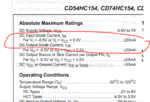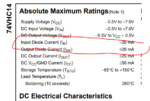mheruian
Junior Member level 3



Good day,
What should I be concern with this? Does this mean that i should always put a series resistor on the input/output pins to control current and avoid ruining the IC? Like if I have dmx having 4 input pins for combinations, i should put 330 ohm resistor in series to each input pins of the dmx to result around 15mA current going in the input pins? (5v / 330 ohm = 0.01515 A; from arduino digital output pin 5V to the dmx input pins)??

